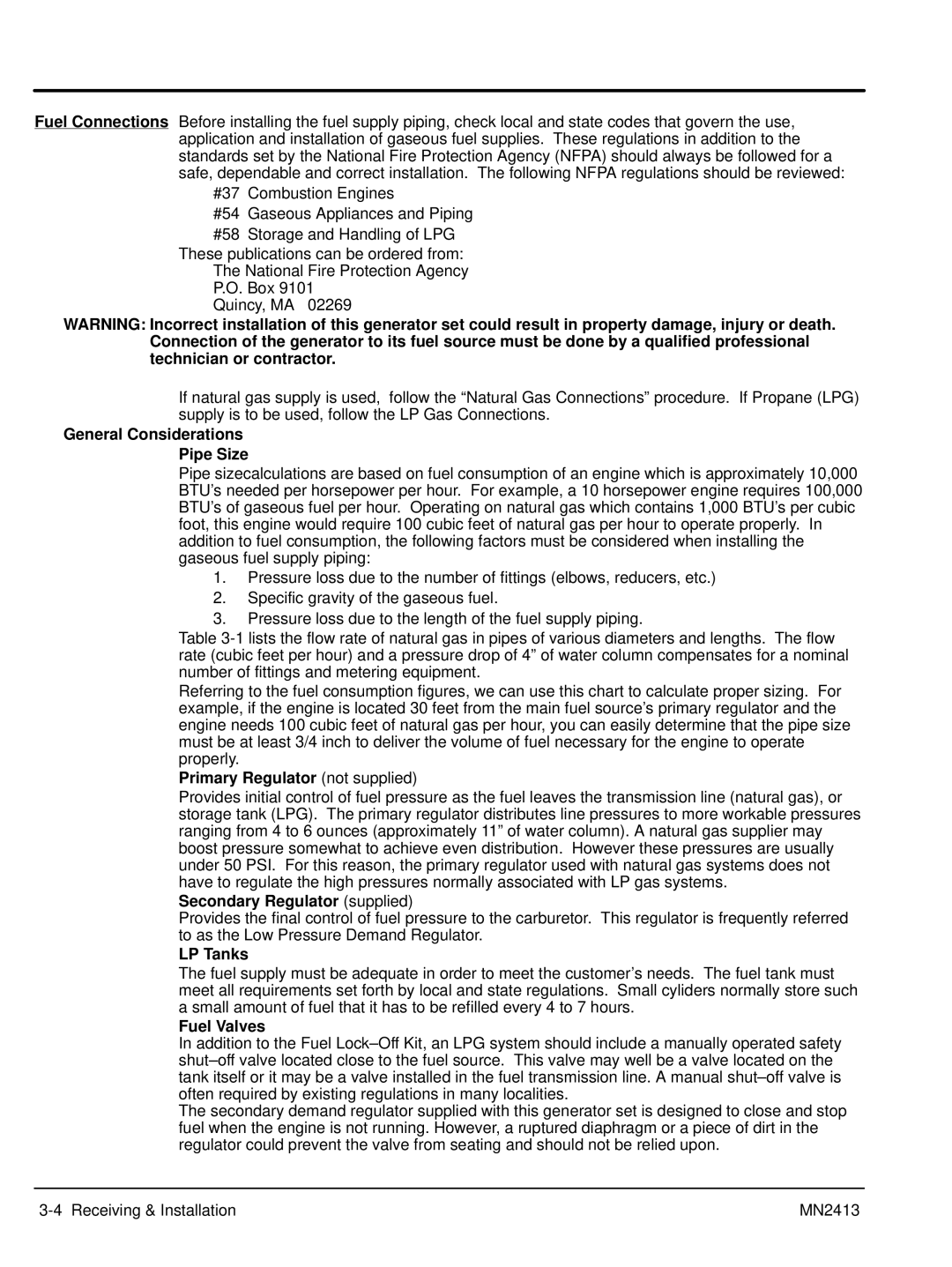
Fuel Connections Before installing the fuel supply piping, check local and state codes that govern the use, application and installation of gaseous fuel supplies. These regulations in addition to the standards set by the National Fire Protection Agency (NFPA) should always be followed for a safe, dependable and correct installation. The following NFPA regulations should be reviewed:
#37 Combustion Engines
#54 Gaseous Appliances and Piping #58 Storage and Handling of LPG
These publications can be ordered from: The National Fire Protection Agency P.O. Box 9101
Quincy, MA 02269
WARNING: Incorrect installation of this generator set could result in property damage, injury or death. Connection of the generator to its fuel source must be done by a qualified professional technician or contractor.
If natural gas supply is used, follow the “Natural Gas Connections” procedure. If Propane (LPG) supply is to be used, follow the LP Gas Connections.
General Considerations
Pipe Size
Pipe sizecalculations are based on fuel consumption of an engine which is approximately 10,000 BTU’s needed per horsepower per hour. For example, a 10 horsepower engine requires 100,000 BTU’s of gaseous fuel per hour. Operating on natural gas which contains 1,000 BTU’s per cubic foot, this engine would require 100 cubic feet of natural gas per hour to operate properly. In addition to fuel consumption, the following factors must be considered when installing the gaseous fuel supply piping:
1.Pressure loss due to the number of fittings (elbows, reducers, etc.)
2.Specific gravity of the gaseous fuel.
3.Pressure loss due to the length of the fuel supply piping.
Table
Referring to the fuel consumption figures, we can use this chart to calculate proper sizing. For example, if the engine is located 30 feet from the main fuel source’s primary regulator and the engine needs 100 cubic feet of natural gas per hour, you can easily determine that the pipe size must be at least 3/4 inch to deliver the volume of fuel necessary for the engine to operate properly.
Primary Regulator (not supplied)
Provides initial control of fuel pressure as the fuel leaves the transmission line (natural gas), or storage tank (LPG). The primary regulator distributes line pressures to more workable pressures ranging from 4 to 6 ounces (approximately 11” of water column). A natural gas supplier may boost pressure somewhat to achieve even distribution. However these pressures are usually under 50 PSI. For this reason, the primary regulator used with natural gas systems does not have to regulate the high pressures normally associated with LP gas systems.
Secondary Regulator (supplied)
Provides the final control of fuel pressure to the carburetor. This regulator is frequently referred to as the Low Pressure Demand Regulator.
LP Tanks
The fuel supply must be adequate in order to meet the customer’s needs. The fuel tank must meet all requirements set forth by local and state regulations. Small cyliders normally store such a small amount of fuel that it has to be refilled every 4 to 7 hours.
Fuel Valves
In addition to the Fuel
The secondary demand regulator supplied with this generator set is designed to close and stop fuel when the engine is not running. However, a ruptured diaphragm or a piece of dirt in the regulator could prevent the valve from seating and should not be relied upon.
MN2413 |
